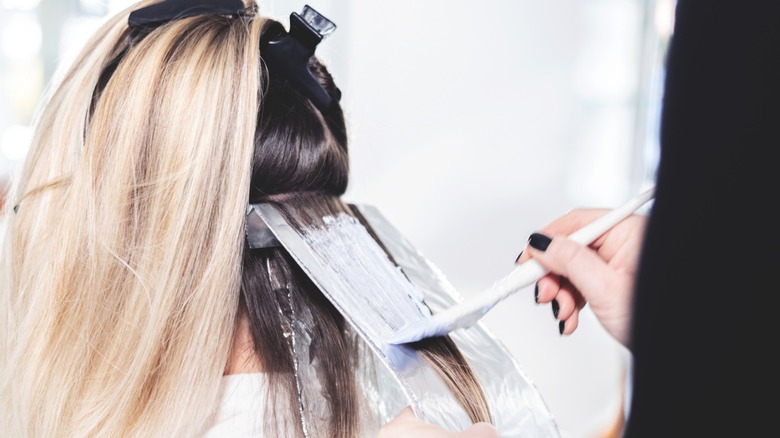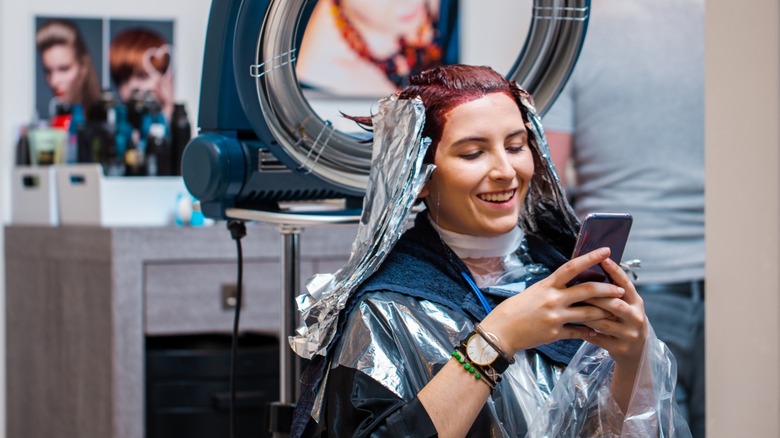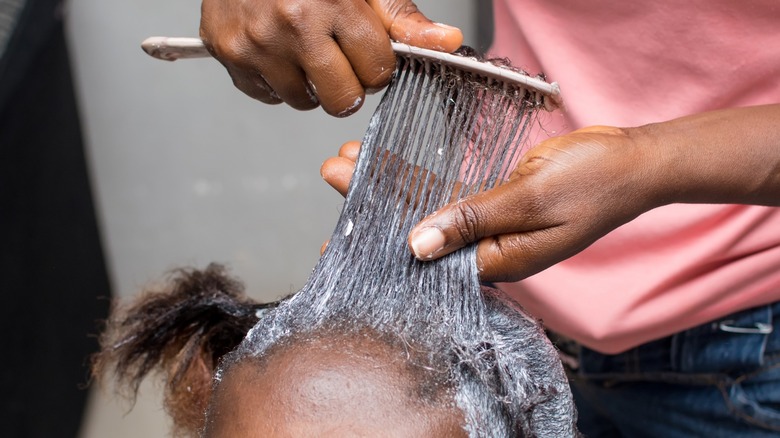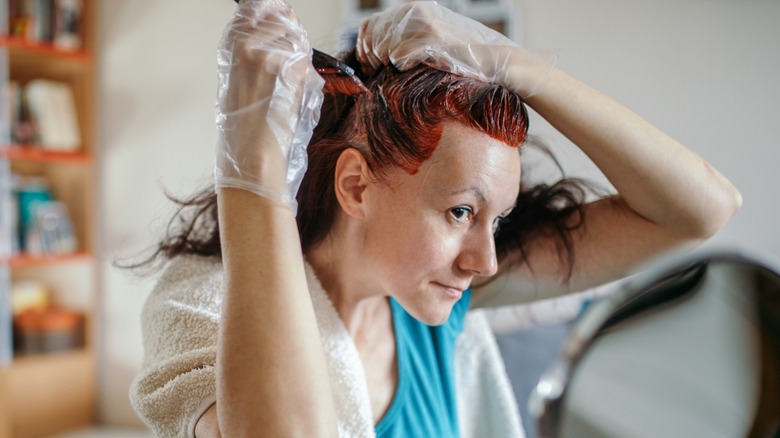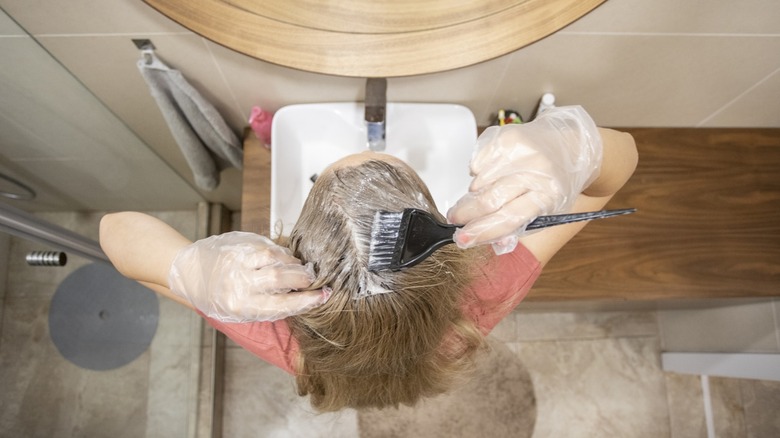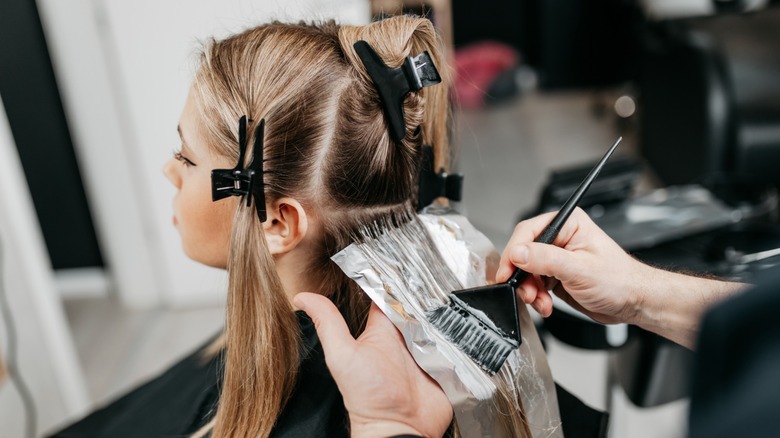Your Guide To All The Different Types Of Hair Dye
If you've ever dyed your hair, you know there are a few ways to do it — all with varying results. You can dye your hair permanently, for a few weeks, or even just for a day or two. While the method you choose will mostly depend on how long you want the color to last, there are a few other factors to take into consideration. And there's a lot to know about dying your hair for the first time.
You'll need to think about how much upkeep you're willing to do — permanent dyes can mean regular salon trips to cover root regrowth — as well as consider speaking to a professional about the condition of your hair. That's because some damaged hair may not take well to some dyes. For example, if your hair is damaged and brittle, your chosen dye may not penetrate the way it should, and the overall result could end up looking patchy. It's also imperative that you do a patch test before you apply any dye to your body, as you can have some serious reactions if you're allergic to the ingredients.
With all that in mind though, dyeing your hair can be one of the most confidence-boosting, freeing ways to express yourself. That's why we're breaking down the different types of hair dye out there so you can make the right decision as you start your fabulous new hair journey.
Permanent hair dye
Permanent hair dye is exactly what it sounds like: dye that changes the color of the hair permanently. Unlike the other methods here, this cannot be undone. Your only options are to re-dye the locks or let your hair grow out. Permanent hair dye is typically a mix of ammonia and peroxide that's then developed to penetrate the hair shaft, changing the color.
This is the best method for anyone looking to change their hair without having to hit the salon every few days. Most people find they need to touch up their hair around every six weeks to keep up with root coverage and vibrancy, but permanent dye won't wash out no matter how many times you shampoo and condition your locks. It's worth noting though this style of dye can still fade over time, which is why you need to make sure you've considered the pre-dye and post-dye process, including swapping to hair products designed for colored hair. It's also a good idea to wait at least 24 hours to wash your hair after dyeing it so you don't dull your locks.
Equally, because of the chemicals and process involved with permanently dyeing the hair, it can make the hair very susceptible to damage (more than any other method). The cost of a permanent dye session depends on a number of factors, such as your location and the condition of your hair, but you can expect to pay between $55 and $180 for this process.
Demi-permanent hair dye
A step below permanent hair dye is demi-permanent hair color. Demi-permanent dyes can last up to 24 washes, which for most people is around one to two months. This dye works by penetrating the hair shaft, but even though it doesn't just sit on your tresses, this style will still fade with each wash. Demi-permanent dye also isn't capable of lightening the hair, because unlike permanent color, demi-permanent dye doesn't contain ammonia. It is mixed with developer to get that longer wear time, but anyone hoping for a temporary color that's lighter than their locks will need to lighten it with permanent dye first to get the shade they're looking for.
Many people tend to reach for the demi-permanent dye when trying out a trendy shade that they may not want to keep in the long term. Pink hair, for example, is a good candidate for demi-permanent dyes. And although this dye does permeate the hair shaft, it still causes less damage than permanent dyes. If your hair needs to be lightened before the demi-permanent dye can be added, the whole process could cost anywhere between $110 and $364.
Semi-permanent hair dye
Semi-permanent hair dye lasts around eight washes, and doesn't contain ammonia or peroxide like permanent dyes. Also unlike with permanent and demi-permanent dyes, it doesn't need a developer because it only coats the outside hair shaft without penetrating it. Because of that, it causes less damage to the hair than permanent dyes can, because it's not as invasive. Although, as we already know, it still can't lighten the hair because it's not a permanent dye.
Semi-permanent dyes are often used by people in between salon appointments to help cover things like stray greys or root regrowth. It's also a useful method to extend the vibrancy of a permanent hair color before it can be redone by a professional. Of course, many people also use semi-permanent dyes when they want to give a new color a go for a few weeks without the same damage or commitment permanent dyes require. A wide range of semi-permanent hair dyes can be bought over the counter and done at home, as long as you make sure you do a patch test and do exactly what it says on the box. The price will vary depending on factors such as the brand and the color, but you can probably expect to pay around $20 for a semi-permanent box dye.
Temporary hair dye
Unlike semi-permanent hair dye, which lasts a few washes, temporary hair dye (which you may also know as wash in, wash out color) is designed to last only until the next time you wash your hair. It's covers the hair in pigment that doesn't ever permeate the shaft. That's why it shouldn't last once you've washed your locks, as the shampoo easily washes out the color. This kind of color is not strong enough to lighten the hair, it can only temporarily darken it or add a tint.
This method is perfect for those who want a very temporary color that won't be too damaging to the hair, or who want to try a different hair color for a short period of time. It is important to note, thought, that some people may end up with hair that is stained for longer than they want, particularly those with lighter or bleached locks who apply dyes regularly.
Still, temporary color can be a useful way to test out a new color without the commitment, or for changing up your look for something like a Halloween or costume party. Temporary hair dyes tend to be one of the cheapest options available, too, as they don't require a professional to apply them. As long as you read the instructions and do a patch test first, the dye can be applied easily and fairly cheap at home. In fact, you can grab some big brand temporary dyes for less than $12.
Variations on each type of hair dye
Not only do we have permanent dye, demi-permanent dye, semi-permanent dye, and temporary hair dye, but each has its own sub-category, too. Falling under the permanent dye category is the likes of bleach, which permanently lightens the hair by stripping it of its color. This is the best method for those looking to lighten their hair or go blonde. Just remember that bleaching can be damaging, require a lot of maintenance, and might set you back as much as $150 to $400 for a professional treatment.
When it comes to semi-permanent dye, one of the most popular techniques is known as color glaze (or color gloss). That's when a see-through glaze is applied over the hair to really enhance the shine. This won't totally alter the overall color of the hair, but it can temporarily change the tone. It can be done by a professional or at home and can last up to 12 washes at a cost of around $30 to $60.
Henna is another example of semi-permanent hair dye. For those looking for darker dye, this more natural method can give the hair a brownish red look, and last between four and six weeks. Because it's natural and not permanent, it won't damage the hair in the same way permanent dye chemicals can, but will set you back around $15 for an at-home kit.
